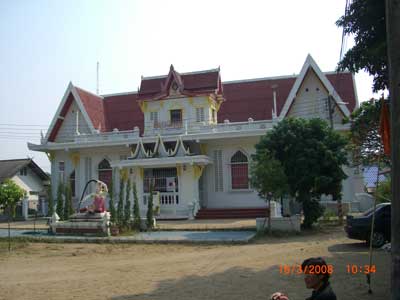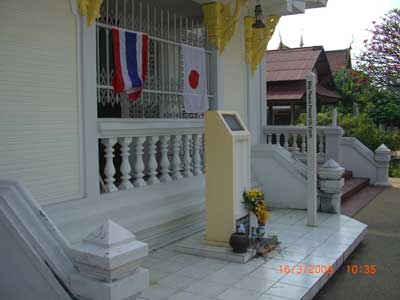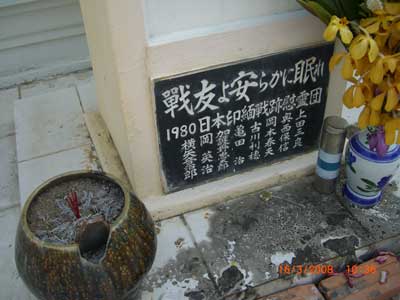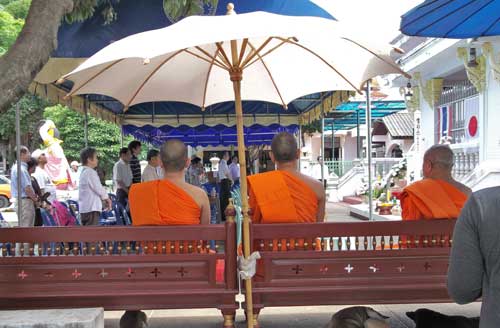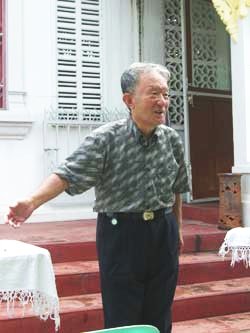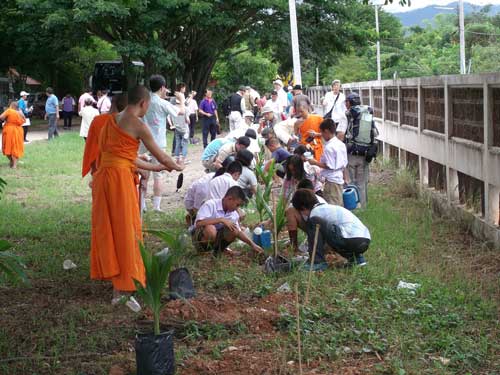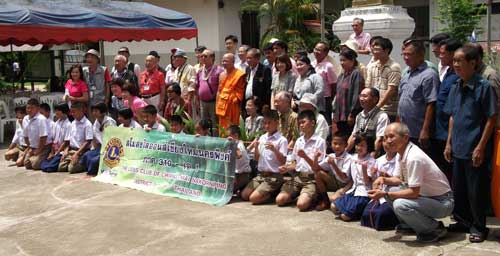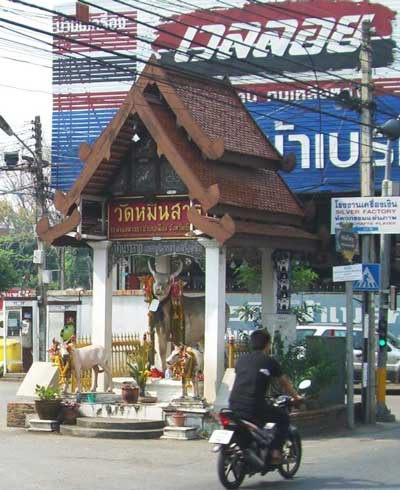Japan in Northwest Thailand during World War II
| N18°46.63 E98°59.10 | Wat Muen San (Th: วัด หี่มนสาร / Jp: ワツトムンサーン ) page 2 of 2 |
Route 0108a |
| Text | Notes | ||||||||||||||||||||||||||||
|
A Japanese War Memorial Hall commemorating fallen IJA veterans lies within the wat compound; Built in 1981,[13] it serves as an exhibit hall for both those remembering WWII and for those interested in the history of the wat.[14]
Top plaque on stele:[16]
A somewhat more legible view of the plaque is available here. Translation: To our veterans: please rest in peace On 02 February 1970, we veterans visited this field hospital site in Chiang Mai, held a memorial service for our veterans, and donated this monument. [Contributors' names] Veterans' Federation in Japan / Burma-Thailand Battlefield Site Memorial Group[16a]
Translation: To our veterans, please rest in peace
Comment There is little information about Wat Muen San in literature thus far searched. Two primary sources in this general (website) effort have been: 戦没者遺骨収集の記録 ピルマ・インド・タイ (東京: 全ビルマ戦友団体連絡協議会, 1980) [Journal on Collection of Japanese War Dead: Burma, India, Thailand (Tokyo: All Burma Comrades Organization, 1980)] 戦史叢書 (東京: 防衛庁防衛研修所戦史室 (編集), 1966-1979年) [Senshi Sosho, (Tokyo: Defense Agency, National Defense College Military History Room, 1966‑1979)] Neither makes any reference to Wat Muen San.[18a] Exhibits about the IJA at the Memorial Hall are interesting, but offer nothing about the part played by the wat during the war. Ongoing activities at the Japanese War Memorial Hall Services at the Memorial Hall in Wat Muen San have been conducted annually on 15 August since 1995. Here, in 2012, attendees listen as a brief memorial observance from Tokyo is broadcast via the Internet at noon, Tokyo time (1000 hours in Chiang Mai):[18b]
They commemorate not only the end of a calamitous World War II, but also the beginning of a concerted positive effort towards cultivating world peace. Those services are sponsored by Dr Masanao Umebayashi, a retired soil scientist, and they are an integral part of his own personal effort to make a meaningful contribution to world peace: applying his agricultural knowledge, he has implemented and maintained a program for cultivating fruit trees amongst Thai hilltribe peoples since 1995.[19]
Until this year (2012), his chosen tree was the manao,[20] whose fruit, a type of lemon (or lime), has proven very marketable. Incidentally, and with some humor, to avoid possible difficulties with his Japanese name in a Thai environment, he shortened his first name, Masanao, to Manao, and locally adopted the name, Dr Manao --- a modern day Johnny Appleseed.[21] This year, he changed his chosen tree to a dwarf coconut palm.[22] On 08 July 2012, he oversaw Lions' Club contributors, local and Japanese, planting young trees at Ban Khuean Phak School:[23]
A group shot of participants:[24]
The tree-planting effort continued under his aegis on some steep slopes in the Queen Sirikit Botanical Garden in the afternoon.[24a] Driving southwest on Wua Lai Road from Chiang Mai's South Khlong Road opposite Chiang Mai Gate, one will see this structure with "cattle statues" on the left at an intersection:[25]
Turning half-left here in front of the structure will lead directly to Wat Muen San.
To Do List
|
13.^ Source required. This date may be related only to the memorial stele in front of the Memorial Building (actually the stele is dated 1980, not 1981) rather than the building itself. e-Citylife Chiang Mai, 14:10, Oct 2005 recalled in "10 Years Ago This Month" (but actually 12 years before, in 1993): "In Wat [Muen San] on Wua Lai Road, (half way down on the left) there is a small shrine left behind by Japanese who were billeted at the temple (used as hospital), [the] shrine probably in memory of those who died. Wrote Isao Sakamoto, Japanese Consul in Chiang Mai." Conclusions to be drawn here are that: 1. The Memorial Hall is not mentioned by the Japanese Consul in 1993, which implies that the hall had not yet been built by 1993. 2. Thus, the stele, with plaques dated 1970 and 1980, existed before the Memorial Hall. 3. As yet unknown is where the 1970 plaque resided until it was incorporated in the stele with the 1980 plaque at its base. And where that stele resided until it came to be seen today in front of the more recently erected Memorial Hall. The earliest Google Earth view of the wat compound currently available is dated 28 Apr 2002 and appears to show at least an outline of the Memorial Hall. This would be consistent with a brochure* in Japanese which indicates that the "museum" was established in 2002. The outline would therefore have been of the museum under construction. Hopefully Google Earth will continue to add earlier views to help clarify this matter. *ムーンサーン寺院資料館のご案内 (Information on the the Wat Muen San Museum), undated. 14.^ CIMG2892.jpg 15.^ CIMG2894a.jpg 16.^ CIMG2896b.jpg
16a.^ Organizations are not yet identified. 17.^ CIMG2895.jpg
17a.^ The date is 1980, which could imply a relationship with IJA veteran efforts to recover remains of war dead in the late 1970s (as documented in 戦没者遺骨収集の記録 ピルマ・インド・タイ). 18.^ part CIMG2892.jpg
18a.^ I would be very happy if someone could correct me on this.
18b.^ DSCF1316a.jpg
19.^ Dr Masanao Umebayashi, aka Dr Manao, was awarded the 2012 Sano Tozaburo Special Prize for his ongoing fruit tree planting program in northern Thailand. In 2008, he was cited in the Japanese Foreign Minister's Commendations for FY2008, for his "Promotion of International Cooperation in Thailand" [a reference to his ongoing voluntary fruit tree planting program for northern Thai hill tribes]. He maintains THAItalk website, which describes tree planting efforts; previously Weekly Talk website for same purpose (both in Japanese). In addition, he monitors a blog at "Dr Manao Talk BBS". He is a member, Royal Swedish Academy of Agriculture and Forestry. Good summaries (in Japanese) of his efforts are at Peoples Life and Bangkokshuho. Photo: CIMG5739b.jpg 20.^ See 21.^ John Chapman: American pioneer nurseryman who introduced apple trees to large parts of [frontier America]. 22.^ See Wikipedia, "Coconut" for comparison of dwarf and tall coconut palms. 23.^ N19°20.0 E99°08.9
24.^ DSCF1232a.jpg
24a.^ No photos for this event: my camera ran out of battery.
25.^ CIMG2898b.jpg The story of the "cattle statues" is told here.
|

